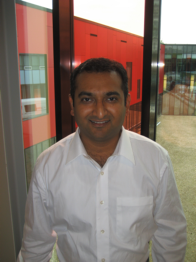Catalytic microreactors for aqueous phase reactions – carbon nano fibers as catalyst support
Promotion date: 29. October 2010
Promotors: Prof. dr. ir. Leon Lefferts
Assistant Promotor: Dr. Kulathuiyer Seshan
| Microfabrication techniques are increasingly used in different fields of chemistry, to realize structures with capabilities exceeding those of conventional macroscopic systems. Microfabricated chemical systems have a number of advantages for chemical synthesis, chemical kinetics studies and process development. Currently, there is a tremendous interest to develop microstructured catalytic reactors for multiphase and/or heterogeneously catalyzed liquid phase reactions, comprising modified catalytic coatings on their internals. The use of structured catalyst supports, i.e. rigid, orderly arranged support materials, such as carbon nanofibers (CNFs), is a prospective option in this respect. This thesis work describes various aspects of the development of carbon nanofiber supported catalyst layers, on structured internals of microreactors made from silicon technology based materials (e.g. fused silica and/or silicon). These microreactors are intended to be used for heterogeneously catalyzed liquid phase reactions, in this case for aqueous phase removal of nitrite and bromate (increasingly found typical water contaminants), to evaluate the performance of such systems and demonstrate the benefit of CNFs as an ‘open-structured’ support over conventional catalyst support materials. |
Was the research fundamental or more application oriented?
It was an application oriented research project, dealing with a feasibility study that worked out very well. The research was sponsored by MicroNed Program in collaboration with industrial partners, e.g. Lionix, a spin-off company founded at the University of Twente.
Using catalysts, anchored on carbon nanofibers in a systematic reproducible way, is very promising for multiphase and/or heterogeneously catalyzed liquid phase reactions. An efficient way to fill the microchannel volume is integrating small pillar structures, using deep reactive ion etching techniques. The contact surface area also increases significantly in this way.
Was it a typical MESA+ kind of project?
Very much so! As a member of the Catalytic Processes and Materials Group, I worked closely in collaboration with dr. Roald Tiggelaar of Mesoscale Chemical Systems. He prepared the microreactor chips with channels containing pillared structures, on to which catalytic CNF layers were synthesized by me.
Both for him and for me, our collaboration broadened our view. After we got used to one another’s expertise, we could benefit and come up with creative new ideas. The project involved highly collaborative teamwork and brought together people from different backgrounds.
This was obviously sustained by the very high standard of cleanroom and other research facilities, which is the true spirit of MESA+, I believe.
The new nano-lab is delivering MESA+ a new leap forward in the infrastructure facilities, which is promising for addressing future challenges. Also new chairs are emerging. This is a good development too. MESA+ must continue to specialize, at the same time broaden its view, and encompass new trends. These three aspects should work together simultaneously to make possible new successes.
So you had to build up knowledge on new areas?
Being a chemical engineer at first, now I am much more multidisciplinary oriented. During my PhD research I obtained greater insights in material science, surface science studies as well as microfabrication technology.
I liked participating in conferences and presenting the latestest results to the scientific community across the globe, on new areas like novel application of carbon nanomaterials in microreaction systems. Sharing knowledge and discussing one’s research topic with international experts is very stimulating.
It works out both ways: one learns a lot personally, and by communicating one can promote his own research topics and of MESA+. I found that, incorporating CNF as catalyst support materials in microchannels for performing chemical reactions efficiently, leading to a novel microreactor concepts - is a topic that many researchers are willing to listen to. I received nice reactions from all over the world in various conferences including those in Japan, US, Spain and Germany.
Did your work lead to well-ranked publications?
Yes, we sent in quite a few publications. Including the one under preparation we had four or seven articles published and two are submitted. They are communicated for example in the Chemical Engineering Journal, Applied Catalysis B - Environmental. Our work resulted in more than twelve oral presentations and ten poster presentations at various conferences all over the world.
What are your future plans?
Personally, I prefer academic research over industrial research because of the great freedom I experience. Now I am working as a post-doc, to study the catalysis on a single particle scale.
Also, I like to work in a vibrant atmosphere together with young students who are enthusiastic about research and are open to new ideas.

